
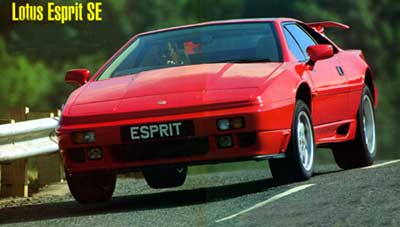
Highly
practical supercar, Huge performance from 4-cylinder engine.
Major changes to cockpit, rear styling
Performance Car (New Car Supplement) November
1991
by Peter Tomalin. Photography by Gary Stuart
A supercar has at least eight cylinders, slugs back high-octane fuel at a rate of no more than 15mpg, is totally impractical for everyday use, and costs, ooh, at least £60,000. Yep, that seems about right. Trouble is, no-one appears to have told Lotus.
The Esprit SE certainly looks every inch a supercar. And it most definitely goes like one, with a top speed well in excess of 160mph and 0-60 in a tarmac-trembling 4.7 seconds. But, hang on chaps, it cost less than £50,000. That really won't do at all. And it does will over 20mpg. On unleaded! That's just not cricket. And what's this? Four cylinders? You've got to be joking. You'll be telling us it's actually useable next . . .
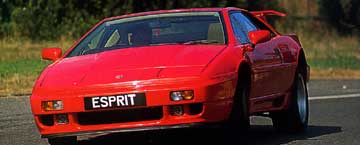
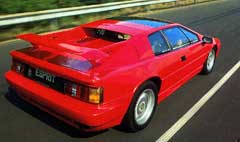
Well it is. Indeed, in revised 1992 form (high-wing), the Esprit SE is more useable than ever. More exotic looking too, with its radical new rear wing, though as with everything at Lotus there are sound engineering reasons for that.
The high-mounted wing is the most obvious change for 1992, but there are others, mostly inside. First, the doors open a little wider, making entry easier. Once in, you find there's considerably more room – more legroom, more headroom – and bigger, gripper seats too. The pedal box has been redesigned to give more footwell space, and the old BL-style heater controls have finally been ditched in favour of Lotus's own. The aim was to make the car more user-friendly, and it's working: the driving environment, never an Esprit strong point, is significantly improved. Why, you can even read the instruments!

The changes are best appreciated on the move. There's more elbow room for wheel-twirling, the seats lock you in place even better than before, the pedals, most noticeably the clutch, have a shorter travel and a lighter feel (though the footwell remains a shade cramped) and rear visibility is usefully improved by dint of the raised wing and larger, freshly raked rear window.
That new wing acts in the 'clean' airflow above the tail of the car and, together with a new shallow rubber bib at the front, reduces the drag coefficient to 0.33. This raises the maximum speed by 2mph to 165mph. More important, there's almost zero lift, which improves stability at high speed, reducing the car's tendency to understeer.
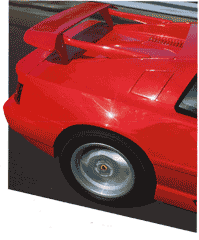
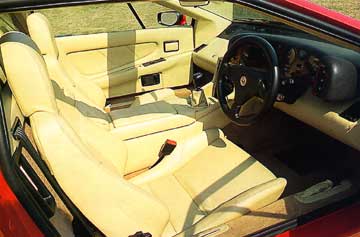
Finally, the old 'glassback' over the rear deck has gone, replaced by a simple flat tailgate with moulded-in vents to extract heat from the engine bay.
The chassis is unchanged, which means it still grips and thrills with the best of them, and mechanically it's the familiar Esprit Turbo SE, with Lotus's 2.2-litre 16-valve fuel-injected and turbocharged 'four' producing 264bhp at 6500rpm and 261lb ft torque at 3900rpm.
What makes this engine special is the liquid-cooled charge air cooler, or 'chargecooler', which connects the turbocharger compressor directly to the plenum nozzle, maximising heat transfer with minimum pressure loss and providing short burst of even more power for truly sensational acceleration. And because Lotus's supercars are meant to be driven regularly, not coddled by collectors, there's a three-way catalytic converter to clean-up the exhaust.
Best news of all is that when the 1992 Esprit SE, now the only Esprit available, goes on sale at Motorfair, Lotus confidently expects the price to be unchanged at £47,310.
It's been a tough old year for the Hethel company, but still has the people – and the cars – to ride out of the recession and come out fighting in '92.
|
|